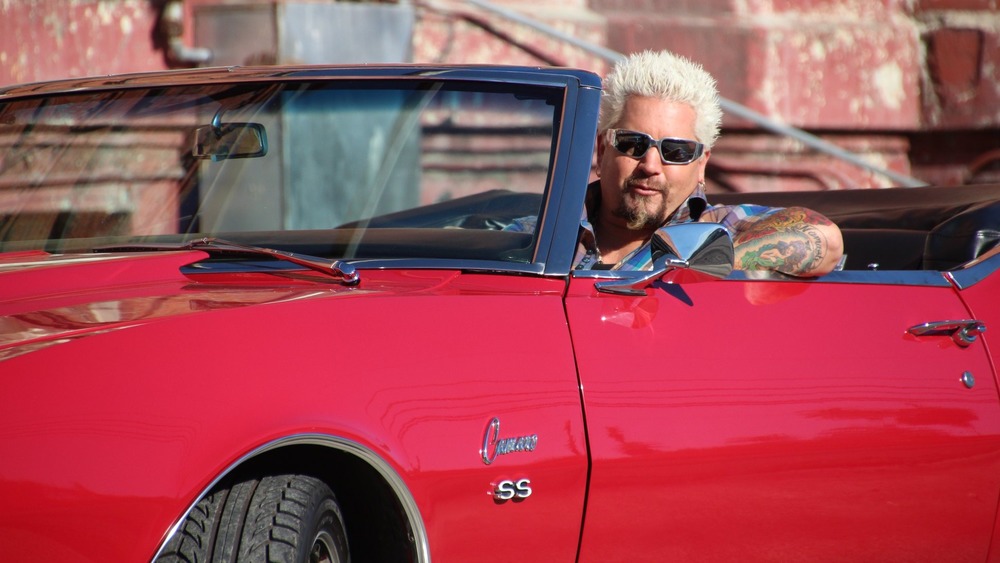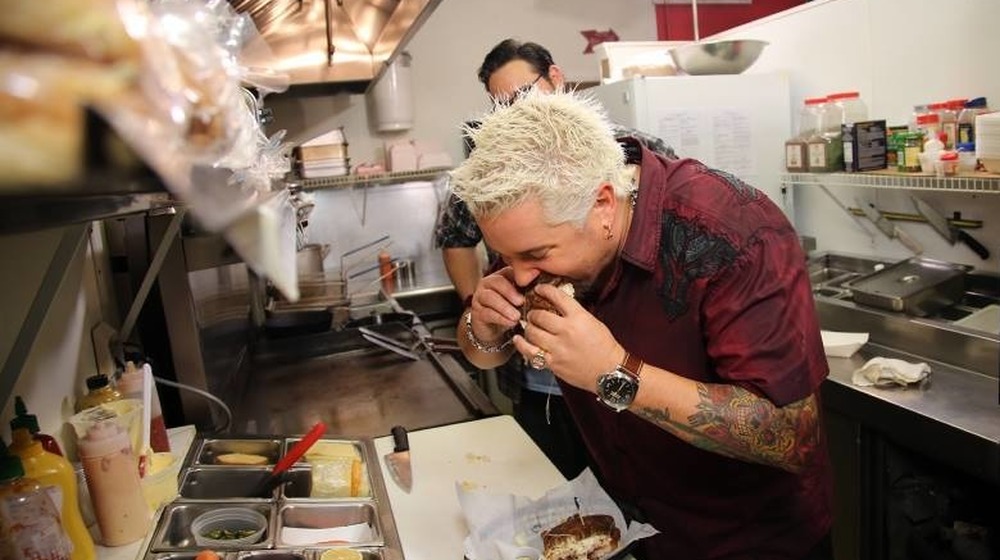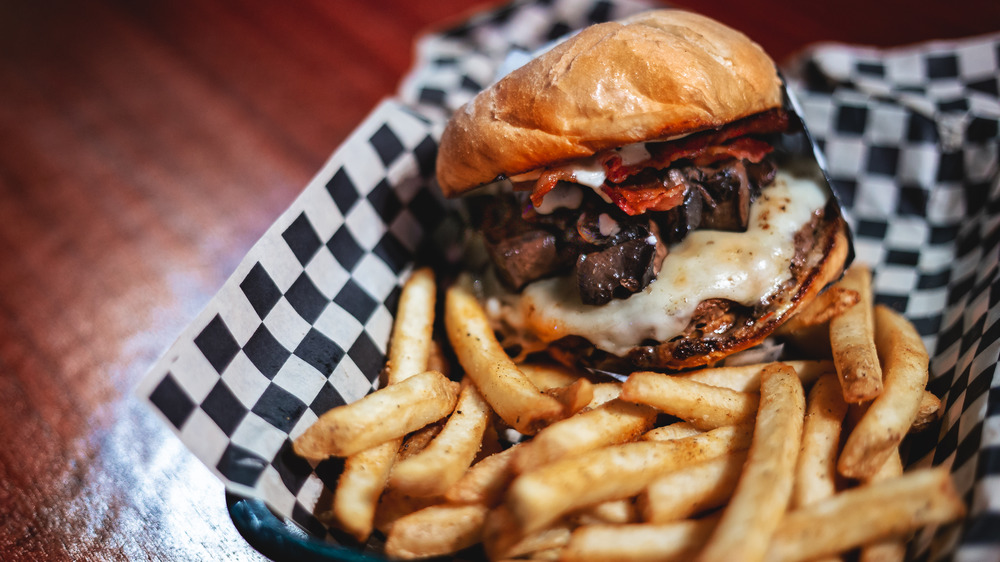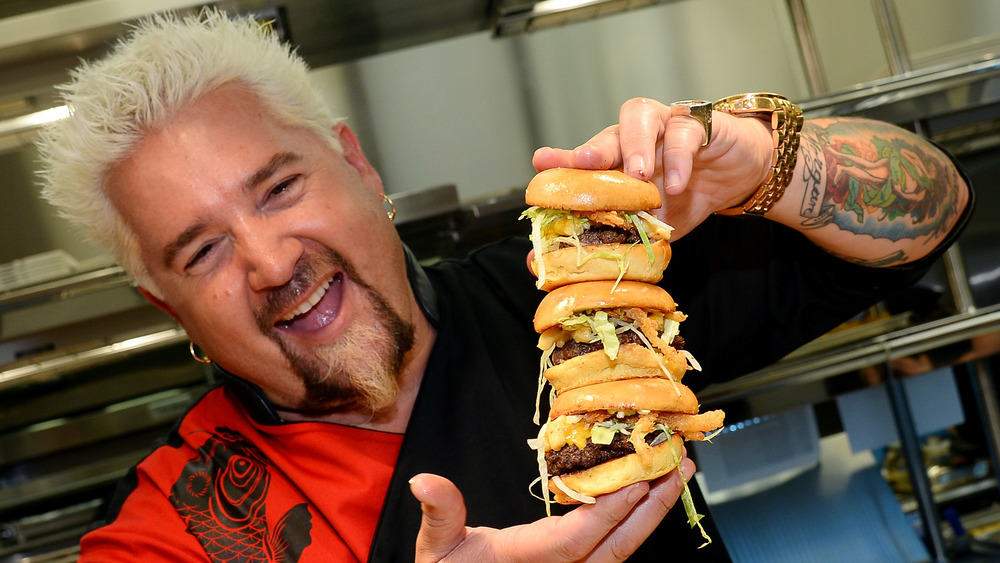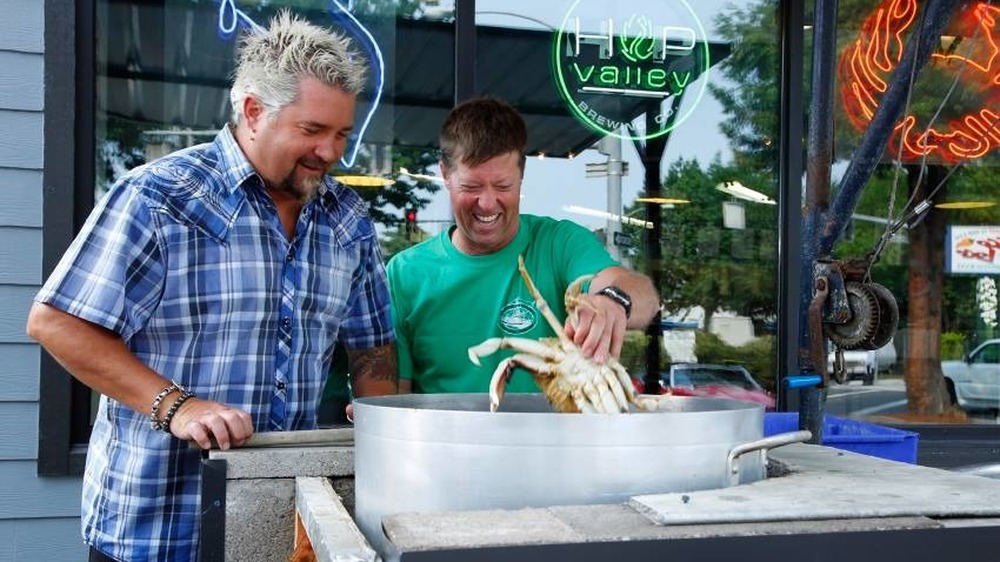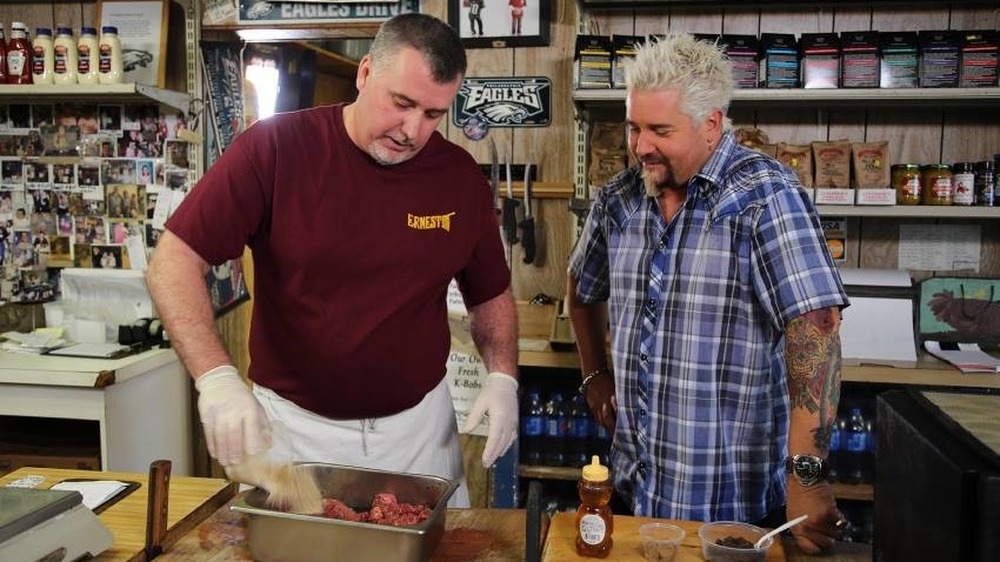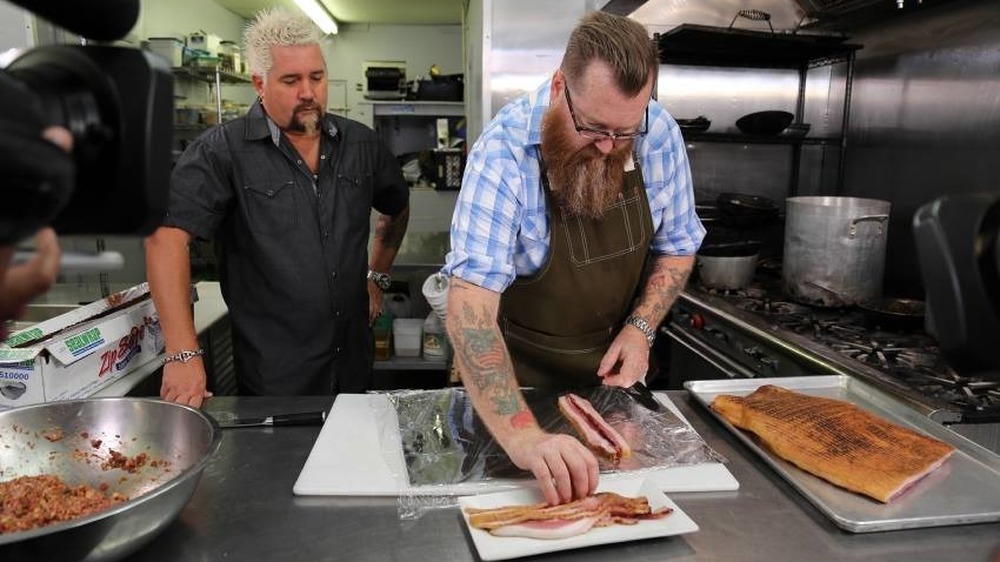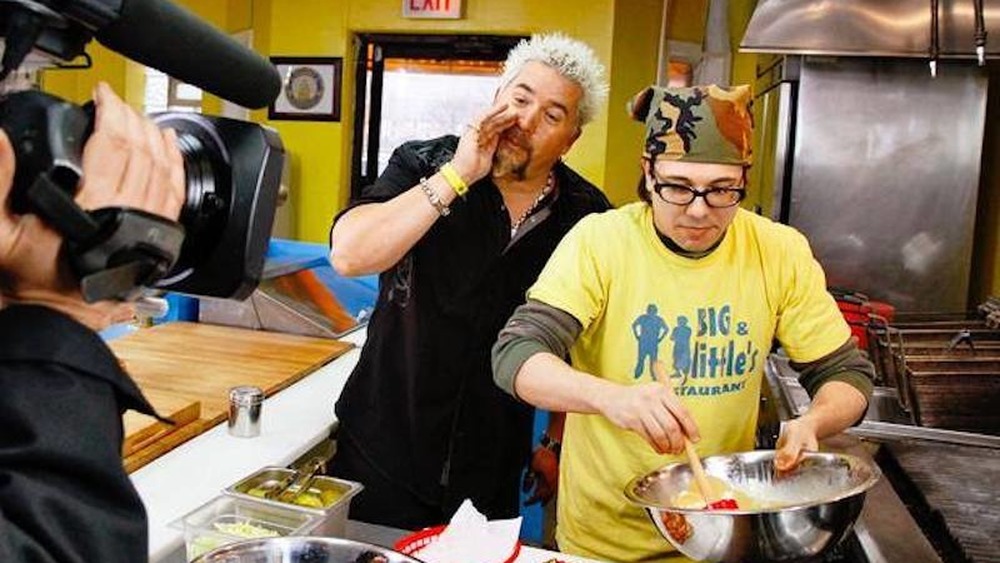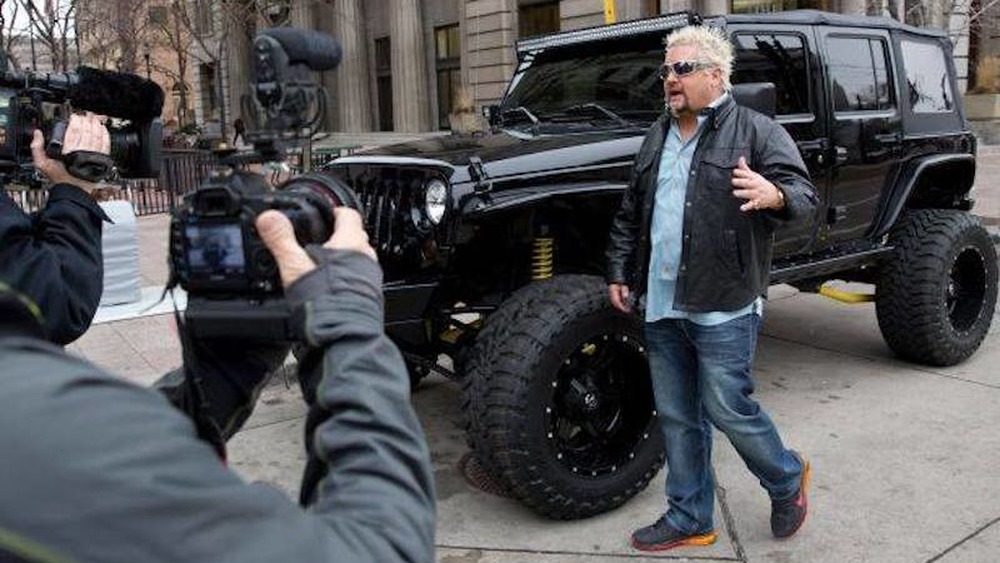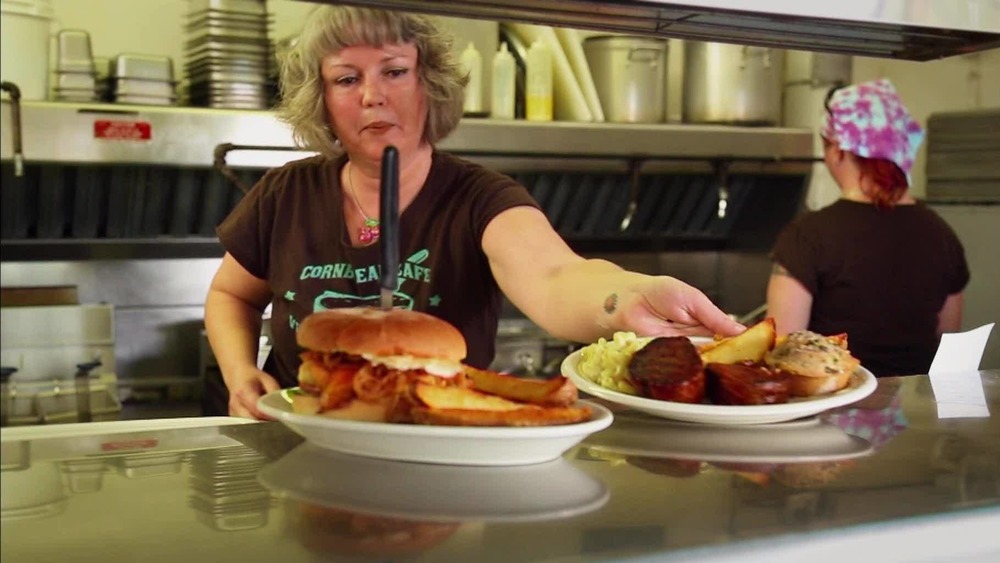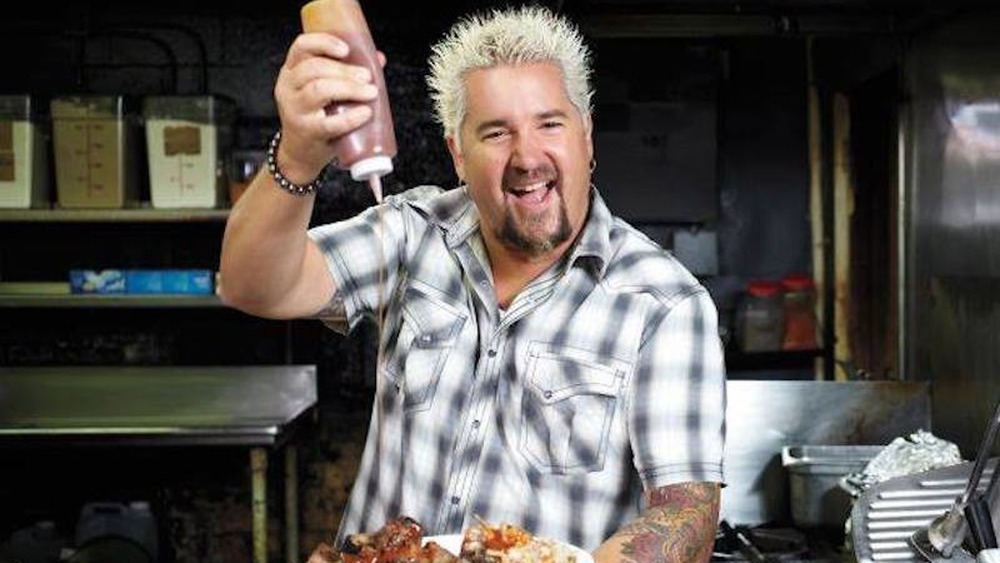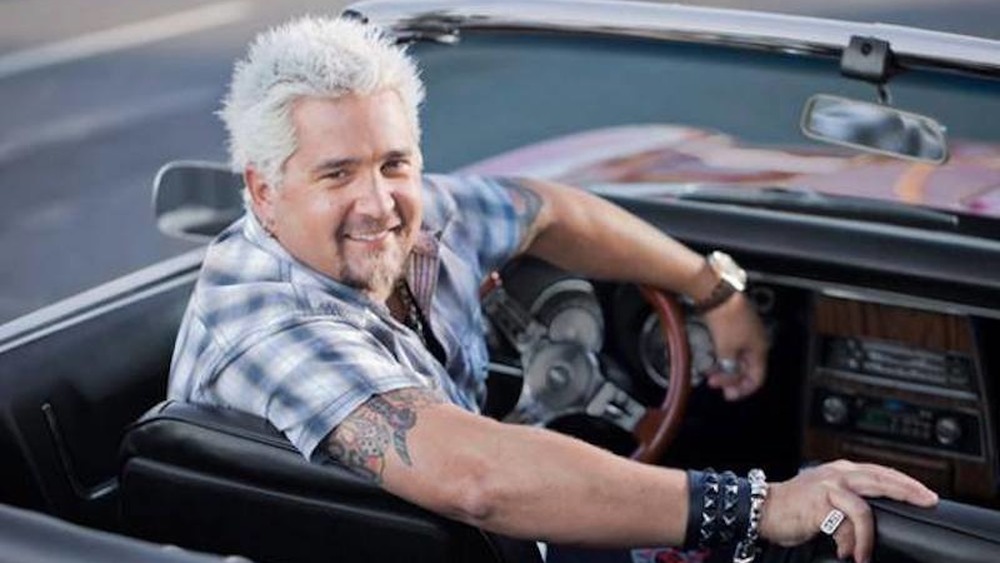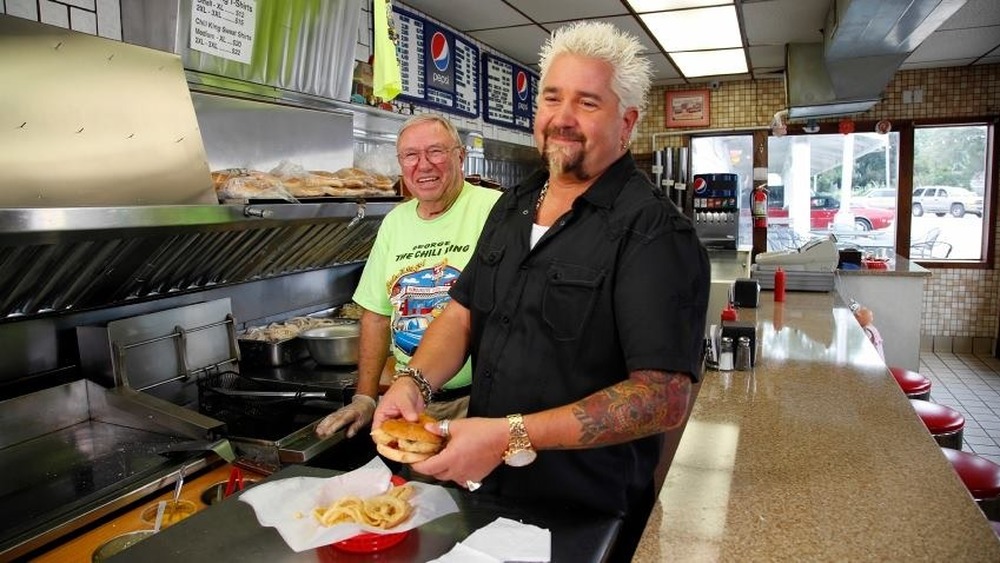Weird Rules Restaurants Are Forced To Follow On Diners, Drive-Ins And Dives
We may receive a commission on purchases made from links.
Whether you're a die hard fan, or can barely stand the exuberant and frosted-tip energy of Guy Fieri, chances are, you've seen an episode of Food Network's Diners, Drive-Ins and Dives. The show has been traversing the country in search of the best small-town cooks and down home local flavors since 2007. Nearly 40 seasons later, Fieri and his team have showcased the unique, often greasy, usually delicious specialties from hundreds of independent chefs and restaurant owners in all 50 states — and Americans are hooked. There are websites dedicated to compiling every single restaurant that makes it on the show, and road trip itineraries dedicated solely to Flavortown food tours.
For the local businesses that get a chance to be featured on Triple-D, as the show is affectionately known, it's a life-changing experience. The "Triple-D Effect" is almost instant for most restaurants, who start seeing a rush of new business from the moment their episode airs.
There are thousands of local eateries around the country that would kill for the opportunity to show off their chops on Triple-D, but not everyone makes the cut, and those that do have strict guidelines to follow. Keep scrolling for the inside scoop on the weird rules restaurants are forced to follow on Diners, Drive-Ins and Dives.
Restaurants have to share their recipes in advance of Diners, Drive-Ins and Dives
The production team at Diners, Drive-Ins and Dives get restaurant referrers from a variety of sources. Many people submit ideas directly to the show, and the producers also do an extensive amount of research reading local media, customer reviews, and more. Guy Fieri once told People "Our research team is like, I think they all work for the FBI. That's the kind of group they are."
After a restaurant has caught the eye of the Triple-D team, then the hard work starts. Hours-long phone calls ensue to see if the restaurant is the right fit for the show. A Colorado restaurant that was featured in season 11 told Thrillist that "[The show] reached out to us and we basically had to sell them on our place over the course of a few weeks."
According to restaurant owners who spoke to Twin Cities Business, after being approached by Diners, Drive-Ins and Dives, the businesses had to send all kinds of pictures of their establishment and their food, along with recipes and ingredient lists. Restaurant owners in Sioux Falls who were selected for the show said they had to submit half a dozen recipes for Fieri and his team to review (per SiouxFalls.Business). And it's important to note that all this pitching goes on before the restaurants ever have a guarantee of whether or not they will even make it on the show.
The food better be made from scratch on Diners, Drive-Ins and Dives
Diners, Drive-Ins and Dives may be about showcasing the more low-key, under-the-radar dining establishments around the country, but the flavors they are looking for are anything but. When the team is combing through dozens and dozens of restaurants in any given city trying to narrow it down to just a few, the bar has to be set high.
According to David Page, the creator and former executive producer of Triple-D, the producers heavily vet the quality of food at each restaurant they consider featuring. "Every place we go has to make real food and it has to be good enough," he told Heavy Table. "I say that as a positive; not good enough, just getting by."
The first rule that restaurants have to follow on Diners, Drive-Ins and Dives is that frozen food will never cut it. Page reiterated that "this has to be handmade food... It better be done from scratch. It better be made right. And it better be good." Page also admitted that there have even been situations where the crew arrived at a location and then canceled their plans because "the key to the show is that they have to meet that bar."
Guy Fieri has the final say on everything on Diners, Drive-Ins and Dives
After months of phone calls, research, and recipe testing, restaurants still won't know if they've made it onto Diners, Drive-Ins and Dives until they get the stamp of approval that matters, and that's Guy Fieri's. Everything has to go through him, from the locations, to the restaurants, to the specific dishes that will be featured on the show (per Thrillist).
Additionally, things can change up until the last minute, if that's what Fieri wants. One restaurant owner in St. Paul told Twin Cities Business that on the day the host showed up to film, "I think we cooked every item on the menu three times with Guy," he explained. "He wanted to try everything on the menu, just about. Then they decided what to feature." Another restaurant owner from Wilmington, Delaware told a similar story, revealing to Town Square Delaware that Fieri showed up and "looked at the menu and decided what he wanted to have. He picked two items I would not have predicted but he loved them."
There are two items you can be sure will probably never make it into a featured dish on Triple-D: liver and eggs. Fieri reportedly hates them both (via People).
You have to tell a story on Diners, Drive-Ins and Dives
If you're going to be featured on Diners, Drive-Ins and Dives, you'll be showcasing a lot more than just some ingredients on a plate. The show is also looking to tell engaging stories that highlight small-town spirit and American work ethic, and that takes a lot of work to develop for TV. That means that each restaurant Triple-D considers featuring has to have some kind of interesting backstory — how they came about, why they're important to the community, or what they're doing differently from everybody else. The show's producers and writers work with each restaurant to hone in on what their story is and how to script it for the cameras (via Thrillist).
The owners of Cafe Nooner in Eureka, California shared a peak at that process, detailing their experience being featured on Diners, Drive-Ins and Dives on their website. They wrote that during the screening phase, the producers asked them who the "main character" for their episode was going to be, along with a series of questions to make sure that person could talk about their food and their restaurant in an engaging way.
Restaurants don't get to pick their Diners, Drive-Ins and Dives filming dates
The moment a restaurant agrees to be featured on Diners, Drive-Ins and Dives, they're agreeing to pivot on a moment's notice around the show's production schedule. The businesses don't get any say in the filming dates, but rather are told by the show when to close up shop and prepare for the crew's arrival. And sometimes, that comes with really short notice. When Cafe Nooner got the call that they'd been selected to be on the show, they were told they had six days to get the restaurant ready for filming, after being told to expect at least a month's notice. And in Wilmington, Delaware, the owner of Little Italy restaurant learned she was going to be featured just over a week before the crew showed up, according to Town Square Delaware.
Once the crew arrives, it's a tight schedule of filming for about two days. The first day, cameras capture the atmosphere of the restaurant, plus all those mouthwatering close-ups and beauty shots of the food. At some point on day two, Guy Fieri himself shows up and films his kitchen segment with the chef, as well as his interviews with diners in the restaurant (who were invited, of course). The show's creator, David Page, explained to Heavy Table that the tight schedule is necessary. When the crew arrives in any given city, they're usually there to shoot several different restaurants for different episodes of Triple-D.
The kitchen must be fully prepped before the Diners, Drive-Ins and Dives cameras roll
Making an appearance on Diners, Drive-Ins and Dives is a once-in-a-lifetime experience for independent restaurant owners to get their name out there. So the stakes are high to present their business proudly, and whip up the best plate of food they've ever made for Guy Fieri. And a big part of that is being prepared.
Producers of Triple-D require that restaurants have their kitchens prepped and ready to go before filming begins, and definitely before Fieri arrives, as noted by Heavy Table. That means having all the ingredients laid out and ready to go: veggies are prepped and chopped, herbs are washed and trimmed, seasonings and condiments are measured out, and all the equipment is set up and accessible, according to the Food Network.
After that, the cameras start rolling, capturing the cooking process and beautiful plated up dishes... sometimes multiple times. That's right, restaurants also need to have their kitchens prepped for making multiple rounds of the same menu items, just to make sure the cameras catch every angle of the food. And don't forget those all-important beauty shots of fresh cheese being grated on top, or a closeup of that first forkful of food (via VideoMaker). If you don't get it right the first time... well, you need a fresh plate of food to reshoot with.
Restaurants have to stay on script on Diners, Drive-Ins and Dives
Much of the charm of Diners, Drive-Ins and Dives comes from Guy Fieri's spike-tipped, larger-than-life personality and predictably unpredictable zingers. You never know when something is going to be utterly "funkalicious" or "bomb-dot-com tasty," or perhaps even "put the shama lama in ding dong" (via First We Feast). And that's the magic of the show; Fieri rolls in the kitchen, bringing totally authentic excitement and energy into the scene in a mostly unscripted fashion.
Going off-script may be part of Fieri's job, but for everyone else, there's a meticulous plan of action that has to be followed — and it's a big secret to the show's success. For the restaurant staff, staying on-script is absolutely key if they want to see their episode make it to air; the flow of the episode is scripted out well in advance. So in order to get the story right, everyone has to stick to the plan, according to Heavy Table.
Triple-D's intense filming schedule is also to blame, as the crew spends a full day shooting footage of the cooking and plating process for each dish. Then Fieri shows up the next day to reshoot the whole process with the restaurant chef. Finally, the editors take all that footage and weave it together into the finished episode we see on TV (via VideoMaker). So it's crucial that all the food footage is consistent, no matter which day it was shot on.
Restaurants must be closed while the crew is filming Diners, Drive-Ins and Dives
We can all try and lie to ourselves, but if we knew that Guy Fieri was about to roll up to our favorite local restaurant, many of us would probably be running to snap a spiked-tipped selfie. In order to limit the potential chaos, and make room for a full crew and a bunch of filming equipment, restaurants are told right up front that a condition of getting featured on Diners, Drive-Ins and Dives is closing up shop for a few days during the shooting process.
Now if you're immediately thinking about all those happy diners you see in every Triple-D episode, there's an explanation for that: they're all genuine fans of the food, but for the most part consist of family, friends, and a few loyal customers who are specifically invited by the restaurants to be part of the filming (via People).
Restaurants are responsible for any costs associated with filming Diners, Drive-Ins and Dives
Getting the chance to appear on Diners, Drive-Ins and Dives is pretty much guaranteed to bring in some serious publicity — and customers — for any restaurant (via Eater). The rigorous production process is almost like an investment for the future success that follows Guy Fieri and his red Camaro. On top of that, being on the show requires a financial investment as well; restaurants don't get paid to appear on Diners, Drive-Ins and Dives, and they don't get paid or reimbursed for all the ingredients used during filming.
For some restaurants, the costs really add up, as some have to spend money fixing up and preparing their restaurant for the cameras. The owners of Cafe Nooner mentioned the rush to paint the inside and outside of their restaurant, plus replacing fixtures, removing equipment, and "so much more."
There's also the added cost of lost business from spending several days closed for filming. Several restaurant owners spoke to Twin Cities Business about their experience on Triple-D and said the overall costs were as high as $15,000 between wasted food product and cleaning costs. In the end though, if Fieri is promising a 200 percent increase in business thanks to the show (via Thrillist), those expenses will all be worth it.
Don't try to feed Guy Fieri unless it's Diners, Drive-Ins and Dives showtime
Obviously, getting to be featured on Diners, Drive-Ins and Dives is a major opportunity for any chef. We can't even imagine the feeling of putting your heart and soul into a dish, having Guy Fieri call it "funkalicious," and then go in for that second bite. However, as tempting as it may be to try and put as many dishes as possible in front of Fieri when you get the chance, chefs must resist the urge.
For one, the host isn't interested in extra meals, which makes sense when he's about to chow down for the cameras. Fieri has confessed that on filming days, the only thing he consumes is fruit and veggie juice (via Food Network). And it's not just him, as Fieri says he brings a juicer on the road and makes everybody drink up to boost immunity among the whole hard working crew (via People).
It's also worth noting that the restaurant owners and chefs on Diners, Drive-Ins and Dives likely won't even get much face time with Fieri himself until the cameras are rolling. According to the show's executive producer, this is a production trick, designed to keep everything as authentic as possible for the cameras.
Don't ask to drive the Diners, Drive-Ins and Dives Camaro
When it comes to Diners, Drive-Ins and Dives, there are a few things you can expect in every episode: something greasy, Guy Fieri's backwards sunglasses (maybe even a shirt with flames), and that shiny red convertible. The iconic car happens to be Fieri's own 1968 Chevrolet Camaro (via GM Authority).
However, don't ask to take a joyride in fancy ride. It turns out that even Fieri himself doesn't operate the car during filming, which is estimated to be worth $100,000, and therefore it's off-limits. Additionally, the vehicle is brought from location to location in a trailer (via People).
However, restaurant staff can at least expect to get a picture with the Camaro in between filming, not to mention any lucky people who come by the restaurant and recognize the car — and it certainly attracts attention. Some restaurant staff have been asked to block the windows when folks passing by try to peer in on the filming.
Restaurants are sworn to secrecy during the Diners, Drive-Ins and Dives process
Being considered for Diners, Drive-Ins and Dives brings excitement, anticipation, stress, long days, and lots of fun. But unfortunately, restaurants aren't allowed to share that excitement with many people until it's all said and done. During the interview and production process, restaurants are asked to sign strict confidentiality agreements; they can't let the public know they were chosen for the show. And if word does get out, they aren't allowed to spill any specific details about the filming schedule.
After the Diners, Drive-Ins and Dives crew has come and gone, the waiting game begins. Restaurants are told they'll be notified about 30 days before their episode is set to air on Food Network, but it can be several months after filming before that time comes. Of course, once the secret is out, the real whirlwind begins. As one restaurant owner explained, "it changes your life immediately," (via Thrillist).
